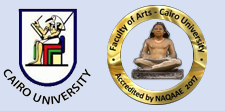عنوان المقال عربي
تحليل عبارات الشکر في اللغة العربية واللهجة المصرية واللغة اليابانية -مصدر لتعليم اللغة اليابانية-
Document Type
Original Study
Abstract English
The present study investigates the features of thanking expressions in Arabic language, Egyptian dialect compared with their correspondent expressions in the Japanese language. The study is the first study to analyze all the thanking expressions in the Arabic language, Egyptian dialect that has been observed in this research. The study came up with the next findings: n Egyptian dialect is quite rich and flexible, not only words with Arabic language origin such as “motʃakker” and “ʃukran” have been observed, but also the expression “Merci” that has a French origin, and “Thank you” have been observed as well. n While “Merci” was mainly used by women from different ages, “Thank you” was used by both male and female with no gender difference, but by young people only. n Both Japanese language and Arabic language share the same way of thanking using apology expressions such as “sumimasen” in Japanese and “asef” or “maʕleʃ” in Arabic. This kind of thanking expression focusses on the load that the other person had to bear for the speaker. This kind of thanking called (plus-minus prospective) n Selection of the thanking expressions to be used depends on the level of load that has been put on the other person regardless of this person is close or not. This point is in complete contrast with the Japanese language, as the speaker selects the thanking expressions based on the relation type with the other person regardless of the level of the load as it has been introduced in the previous Japanese researches. n Thanking expressions in Egyptian dialect tend to use several and different types of expressions in the same thanking utterance or in the same sentence with lengthy thanking conversation aiming to express the deep appreciation of the speaker. n In the present all materials used for teaching the Japanese language in Egypt are developed globally and not oriented for Egyptian learners. This research will serve the goal of developing Japanese language education materials that are oriented for the Japanese language learners of Egyptians.
الملخص العربي
تبحث الدراسة الحالية في سمات تعبيرات الشکر في اللغة العربية واللهجة المصرية مقارنة بالتعبيرات المقابلة لها في اللغة اليابانية. هذه الدراسة هي الدراسة الأولى لتحليل جميع تعبيرات الشکر في اللغة العربية ، اللهجة المصرية التي لوحظت في هذا البحث. توصلت الدراسة إلى النتائج التالية: اللهجة المصرية غنية ومرنة ، لم يتم ملاحظة الکلمات ذات الأصل العربي مثل "موتوکر" و "شکراً" فحسب ، بل لوحظت أيضًا عبارة "ميرسي" ذات الأصل الفرنسي ، و "شکرًا لک" کذلک. بينما تم استخدام "Merci" بشکل رئيسي من قبل النساء من مختلف الأعمار ، تم استخدام "Thank you" من قبل کل من الذکور والإناث دون اختلاف بين الجنسين ، ولکن من قبل الشباب فقط. تشترک کل من اللغة اليابانية واللغة العربية في نفس طريقة الشکر باستخدام تعبيرات الاعتذار مثل "sumimasen" باللغة اليابانية و "asef" أو "maleʃ" باللغة العربية. يرکز هذا النوع من تعبير الشکر على العبء الذي کان على الشخص الآخر أن يتحمله للمتحدث. يسمى هذا النوع من الشکر (زائد ناقص المرتقب) اختيار عبارات الشکر التي سيتم استخدامها يعتمد على مستوى العبء الذي تم تحميله على الشخص الآخر بغض النظر عن قرب هذا الشخص أم لا. هذه النقطة تتناقض تمامًا مع اللغة اليابانية ، حيث يختار المتحدث تعبيرات الشکر بناءً على نوع العلاقة مع الشخص الآخر بغض النظر عن مستوى الحمل کما تم تقديمه في الأبحاث اليابانية السابقة. تميل عبارات الشکر باللهجة المصرية إلى استخدام عدة أنواع مختلفة من التعبيرات في نفس خطاب الشکر أو في نفس الجملة مع محادثة طويلة للتعبير عن التقدير العميق للمتحدث. في الوقت الحاضر ، تم تطوير جميع المواد المستخدمة في تدريس اللغة اليابانية في مصر عالميًا وليست موجهة للمتعلمين المصريين. سيخدم هذا البحث هدف تطوير مواد تعليم اللغة اليابانية الموجهة لمتعلمي اللغة اليابانية من المصريين.
Recommended Citation
Ahmed, Hanem
(2021)
"Analysis of thanking expressions in the Arabic language, Egyptian dialect and Japanese language
-Oriented for the Japanese language education-,"
Journal of the Faculty of Arts (JFA): Vol. 81:
Iss.
3, Article 22.
DOI: https://doi.org/10.21608/jarts.2021.179304
Digital Object Identifier (DOI)
10.21608/jarts.2021.179304
Accept Date
2021-06-22
Publication Date
7-1-2021

